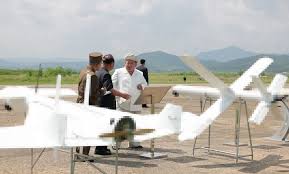suicide drones In a recent display of military advancements, North Korean leader Kim Jong-un unveiled a new type of weaponry—what the regime has labeled as “suicide drones.” This development marks a significant addition to North Korea’s military arsenal and raises substantial concerns for regional and global security. The unveiling of these drones not only highlights North Korea’s ongoing efforts to bolster its military capabilities but also signals potential shifts in the strategic landscape of East Asia. This article delves into the details of the new drones, their potential impact on regional security, and the broader implications for international relations.

Table of Contents
Understanding North Korea’s ‘Suicide Drones’
The term “suicide drones” refers to unmanned aerial vehicles (UAVs) designed to deliver a lethal payload to a target and then crash, effectively functioning as a one-way weapon. Unlike traditional drones used for reconnaissance or precision strikes, suicide drones are intended for a single-use attack, akin to a missile but with the added flexibility of aerial deployment.
**1. Specifications and Capabilities:
Details about the exact specifications of North Korea’s new drones are limited, but several key features have been highlighted:
Payload and Range: The drones are reported to carry explosive charges capable of inflicting significant damage upon impact. While specific range data is not fully disclosed, North Korean state media suggests these drones can reach targets at considerable distances.
Guidance Systems: The drones are believed to be equipped with advanced guidance systems that enhance their accuracy and effectiveness. These systems could potentially include GPS and inertial navigation technologies.
Stealth and Deployment: The design and deployment capabilities of these drones are still under scrutiny. The potential for low radar visibility and the ability to be launched from various platforms could enhance their operational effectiveness.
**2. Strategic Significance:
The introduction of suicide drones adds a new dimension to North Korea’s military strategy. These drones could:
Enhance Asymmetric Warfare: By utilizing suicide drones, North Korea aims to leverage asymmetric warfare tactics. Such drones can potentially target high-value assets or disrupt critical infrastructure without the need for large-scale conventional forces.
Augment Existing Arsenal: The new drones complement North Korea’s existing arsenal of ballistic missiles and conventional weapons. Their integration into North Korea’s military strategy could provide additional leverage in conflict scenarios.
Regional Security Implications suicide drones
The unveiling of North Korea’s suicide drones has significant implications for regional security, particularly in East Asia. Key concerns include:
**1. Increased Tensions with South Korea and Japan:
South Korea: As North Korea’s closest neighbor, South Korea is directly threatened by these new drones. The potential for drone attacks on South Korean military bases, infrastructure, or civilian areas could escalate tensions. South Korea’s military response and countermeasures will be critical in addressing this new threat.
Japan: Japan, which has been the target of North Korean missile tests in the past, is also within the range of these new drones. The possibility of drone attacks on Japanese soil could prompt Japan to enhance its defensive capabilities and seek stronger alliances with regional partners.
**2. U.S. and Allied Responses:
Military Readiness: The United States, as a key ally of both South Korea and Japan, will likely reassess its military posture and readiness in the region. The introduction of suicide drones may lead to increased U.S. military presence or joint exercises with allies to counter the emerging threat.
Diplomatic and Strategic Reactions: The U.S. and its allies may also pursue diplomatic channels to address the situation. This could include strengthening sanctions, engaging in dialogue with North Korea, or seeking support from international organizations to address the growing threat.
Global Reactions and Strategic Implications
The unveiling of North Korea’s suicide drones has drawn a range of reactions from the international community, reflecting the broader strategic implications of this development:
**1. International Condemnation and Sanctions:
United Nations: The United Nations Security Council may consider additional sanctions or resolutions in response to North Korea’s latest military advancements. The international community generally condemns North Korea’s arms development and calls for adherence to existing sanctions and agreements.
Global Diplomacy: Countries with significant geopolitical interests in the region, such as China and Russia, will likely weigh in on the situation. Their responses could influence the dynamics of international diplomacy concerning North Korea.
**2. Military Technology and Arms Race:
Arms Race Dynamics: The introduction of advanced drone technology by North Korea could trigger a regional arms race. Neighboring countries and other global powers may accelerate their own military advancements or procurement of counter-drone technologies.
Technology Transfer: There is also a concern about technology transfer or proliferation. North Korea’s advancements could potentially lead to the spread of similar technologies to other states or non-state actors, further complicating global security dynamics.
**3. Cybersecurity and Countermeasures:
Cyber Capabilities: The integration of advanced drones into military strategies could be accompanied by enhanced cybersecurity measures. North Korea’s ability to potentially integrate cyber capabilities with drone operations may necessitate improved counter-cyber measures by affected countries.
Counter-Drone Technologies: The development of counter-drone technologies and strategies will be a priority for nations facing the threat. This could involve advancements in radar systems, electronic warfare, and defensive countermeasures.
Conclusion: Navigating the New Threat Landscape
The unveiling of North Korea’s suicide drones represents a significant development in the ongoing geopolitical landscape of East Asia. The introduction of such advanced weaponry underscores the challenges faced by regional and global security stakeholders.

As North Korea continues to push the boundaries of its military capabilities, the international community must navigate a complex landscape of strategic, diplomatic, and technological responses. The implications of this development extend beyond regional borders, impacting global security dynamics and necessitating a coordinated approach to address the emerging threats.
In response to North Korea’s advancements, countries and international organizations will need to enhance their preparedness, bolster defensive capabilities, and engage in robust diplomatic efforts. The goal will be to mitigate the risks posed by these new weapons while seeking pathways to stability and peace in a rapidly evolving security environment.







